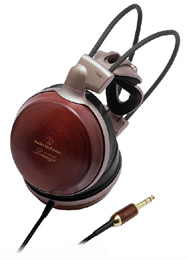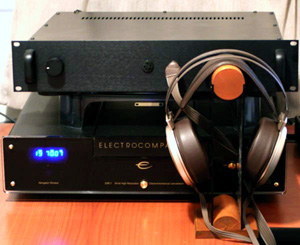![[SoundStage!]](../sslogo3.gif) All In Your Head All In Your HeadBack-Issue Article |
December 2003 The One Thing Far too many audiophiles buy a piece of audio gear only to end up being dissatisfied with it. We have such high hopes, but when we sit down and listen to what we just bought we are often let down. It seems like we are shooting in the dark, not knowing whether or not we have a target, much less if we hit it. One of the reasons for this is that we fall victim to not knowing the "one thing." What do I mean? In the movie City Slickers there is a scene in which Curly (Jack Palance) holds up his hand with his index finger extended and says to Mitch (Billy Crystal) that the secret to life is this. Not getting it, Mitch asks him, "Your finger?" Curly laughs and then proceeds to give some very sage advice. To paraphrase his reply, he says that you have to find that one thing that is so important to you that it makes the rest virtually meaningless. Likewise, we all need one thing that we desire most in sound reproduction. What is that one thing that makes everything else seem unimportant? Here’s an example of how this works. Dave, a relative headphone newcomer, had a really nice Antique Sound Labs MG Head OTL headphone amp along with some Sennheiser HD 580 headphones. He finally succumbed to the inevitable urge to upgrade and bought a solid-state headphone amp. After getting it, he was, well, very disappointed. Why? Was it the amp’s fault? Or was it something else a little more intangible that he couldn’t, as yet, put his finger on? In his case he merely fell victim to not knowing the one thing he preferred above all else, and as such bought an amp that was a move in the wrong direction. Through a series of exchanges we had he was finally brought to the same place that Mitch was when Curly dished out his sage advice. He thought through his priorities in sound, what he liked about his old headphone amp and what he disliked about his new one. When he was done, it came down to his love of the old tube amp’s midrange. He suddenly realized what it was he sought, and then began his search to get a headphone amp that would provide it. With that in mind, I would like to share my own personal experiences and let you know how I arrived at the system I now own. As I wrote in my last article, I started with a Creek OBH-11 headphone amp and Sennheiser HD 600 headphones. When the upgrade bug bit me, it was time for a new headphone amp. After lots of research, I decided upon a Sonic Adventure Reality. I owned it for about a month, did some tube rolling to get the best sound possible from it, and decided it wasn’t for me. I didn’t know why -- I just knew.
The next system up to bat included the highly regarded Audio Valve RKV Mk II, along with the Impedancer to allow the use of headphones with less than 100-ohm impedance, and a set of Sony CD3000 headphones. This amp not only sounded great, but also looked the part. After living with the amp for about four months I once again decided that what I was looking for in my system simply wasn’t there. I couldn’t put my finger on what it was yet, so once again it was time for another complete change. After some research I found a DIY/DIYFO amp designed by Kevin Gilmore and released to the public free of charge. It was appropriately called a Gilmore, and I ordered one from a builder with a DACT stepped attenuator for volume control. Oh boy, suddenly it became clear to me. I had my very own one-thing epiphany. What I couldn’t quite put my finger on solidified in my mind. That one thing that I sought more than anything else was -- drum roll please -- detail. I greatly enjoyed the amount of detail that this new amp provided me. These ears, for the first time, heard things like faint keyboards in recordings that were waaay in the background. Backup singers that had previously backed up so far they had fallen off the stage were now heard for the first time. Boy oh boy, I was in audio heaven.
Well, there you have it. My complete system, pictured here, now consists of a pair of Stax Omega II earspeakers, an electrostatic amp designed by Kevin Gilmore (KGSS for Kevin Gilmore Solid State), a pair of Virtual Dynamics Nite power cords, an Electrocompaniet EMC-1Up CD player as source, and a pair of W Enterprises NW Music Timbre balanced interconnects. Like Curly, I can’t tell what that one thing is for you. It is not to be explained; it is to be discovered. So how do you go about discovering the one thing that makes all else unimportant? Well, that's easy -- time, research, and asking a lot of questions. Take some time exploring your friends’ systems, visit your local audio stores, and keep looking until you find that one thing. Read all you can find online at places that specialize in what you are looking for. Just make sure to spend a little extra time verifying that what you discovered is truly what you seek. And after all this is done, you will then need to do some additional research in finding which components will provide you with what you seek. More on this to come. ...Doug Paratore |
|
![[SoundStage!]](../sslogo3.gif) All Contents All ContentsCopyright © 2003 SoundStage! All Rights Reserved |
 My next stop was a Melos
SHA-Gold Reference. This change included the purchase of the then newly released Audio
Technica ATH-W1000 headphones. The wooden ear cups were so well done that they looked like
they sounded good without ever putting the 'phones on. Sadly, due to various design issues
I had with both the headphone amp and headphones, it was time for another complete system
change.
My next stop was a Melos
SHA-Gold Reference. This change included the purchase of the then newly released Audio
Technica ATH-W1000 headphones. The wooden ear cups were so well done that they looked like
they sounded good without ever putting the 'phones on. Sadly, due to various design issues
I had with both the headphone amp and headphones, it was time for another complete system
change. So once I discovered that one
thing, the only thing left for me to do was what I do best -- take it to an extreme.
Now that I knew that an remarkably detailed presentation was what I craved, I took the
plunge and ordered an electrostatic headphone amp, again designed by Kevin Gilmore, and a
pair of Stax Omega II earspeakers. They didn’t let me down in the least. They are
simply one of the world’s best combinations at providing detail inherent to a
recording. To put it simply, this last, and final, change provided me with what I sought,
and did so in spades.
So once I discovered that one
thing, the only thing left for me to do was what I do best -- take it to an extreme.
Now that I knew that an remarkably detailed presentation was what I craved, I took the
plunge and ordered an electrostatic headphone amp, again designed by Kevin Gilmore, and a
pair of Stax Omega II earspeakers. They didn’t let me down in the least. They are
simply one of the world’s best combinations at providing detail inherent to a
recording. To put it simply, this last, and final, change provided me with what I sought,
and did so in spades.